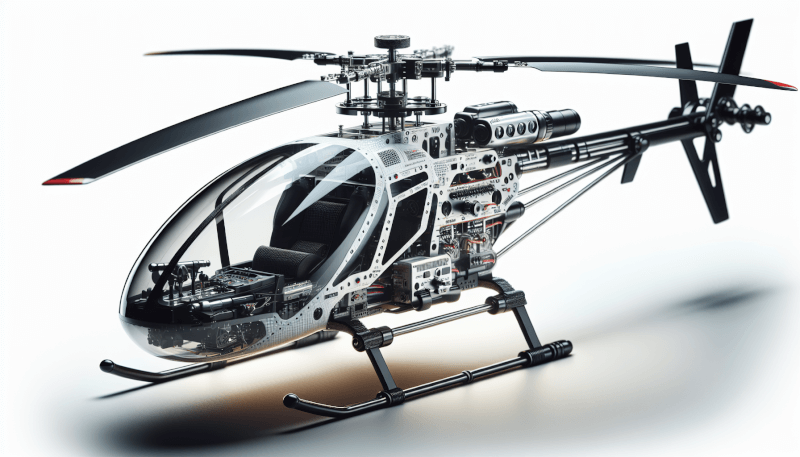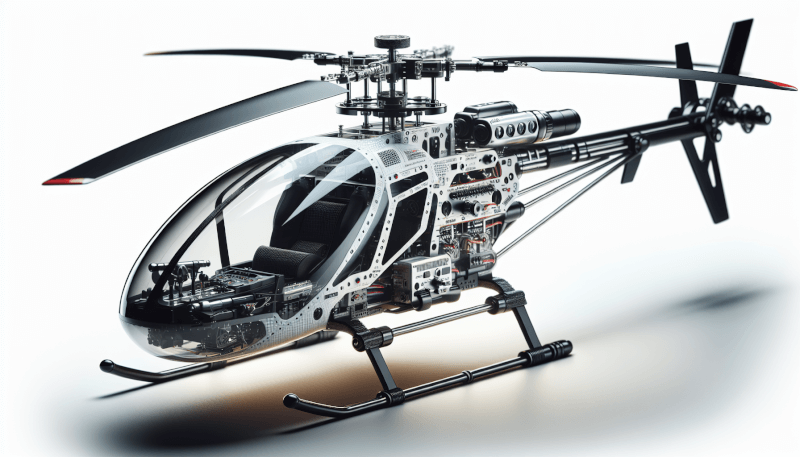So, you’ve finally invested in a remote control helicopter and can’t wait to take it out for a spin. But before you hit the skies, it’s important to learn how to properly store and transport your RC Heli. In this article, we will guide you through the essential steps to ensure the safety and longevity of your beloved investment. From securing the rotors to protecting delicate parts, we’ve got you covered on everything you need to know. So, let’s dive in and get your RC Heli ready for its next adventure!
Choosing a Storage Location
Indoor or Outdoor
When it comes to storing your RC helicopter, one of the first decisions you’ll need to make is whether to store it indoors or outdoors. While both options have their pros and cons, an indoor storage location generally offers better protection for your beloved RC heli. Indoor spaces, such as a dedicated hobby room or garage, provide shelter from the elements and minimize the risk of damage caused by exposure to outdoor elements like rain, dust, and extreme temperatures. Additionally, indoor storage reduces the chances of theft or accidental damage that can occur when the heli is left unattended outdoors.
Temperature and Humidity Control
Regardless of whether you choose indoor or outdoor storage, it’s crucial to consider temperature and humidity control. Extreme temperatures can negatively impact the performance and lifespan of your RC heli, and high humidity can lead to corrosion and damage to sensitive electronic components. To protect your investment, it is recommended to store your RC heli in an area with a controlled temperature and humidity level. If indoor storage is not possible, consider investing in a specialized storage container that provides insulation and protection against these elements.
Preparing Your RC Heli for Storage
Cleaning and Maintenance
Before storing your RC heli, it’s essential to give it a thorough cleaning and perform any necessary maintenance. Dust, dirt, and debris can not only affect the performance of your heli but also contribute to corrosion and other damage. Use a soft, lint-free cloth to gently wipe down the heli, paying attention to remove any accumulated dirt or residue. Don’t forget to clean the rotor blades, landing gear, and any other accessible parts. Additionally, check for any loose screws or other signs of wear and tear that may require immediate attention.
Battery Removal
When storing your RC heli for an extended period, it is recommended to remove the batteries to prevent any potential damage. Lithium-ion batteries, commonly used in RC helis, have a self-discharge rate that can lead to cell imbalance and reduced overall battery life. To avoid this, remove the batteries and store them in a cool, dry place separately. Ensure that the batteries are charged at around 40-60% of their total capacity before storing them, as this is the optimal level to prevent self-discharge while still maintaining some charge.

Securing Your RC Heli for Transport
Disassembling the Rotor Blades
If you need to transport your RC heli to a different location, it’s essential to properly secure it to prevent any damage in transit. One crucial step is to disassemble the rotor blades, as they are the most delicate and vulnerable part of the heli. Carefully remove the blades following the manufacturer’s instructions and place them in a protective case or cover them with a soft material to prevent any bending, scratching, or other damage during transport.
Securing Loose Parts
Before transporting your RC heli, make sure to secure any loose parts that could potentially move or get damaged during transportation. Depending on your heli model, you may have detachable landing gear, antennas, or other accessories that should be removed or properly secured. Use zip ties, Velcro straps, or foam padding to secure any loose parts and prevent them from shifting or banging against each other during transport.
Protective Case or Bag
Investing in a protective case or bag is essential to ensure the safe transport of your RC heli. These specialized containers are designed to provide maximum protection against impacts, vibrations, and other potential hazards during transportation. Hard cases offer the highest level of protection, typically made of durable plastic or aluminum with foam inserts that snugly fit your heli and accessories. Soft cases, on the other hand, are more lightweight and offer flexibility in terms of storage space but provide relatively less impact protection. Choose the type of case that best suits your needs and budget, keeping in mind the importance of providing adequate protection for your RC heli.
Choosing the Right Storage Container
Hard Case
A hard case is an excellent option for long-term storage of your RC heli. These cases are made of sturdy materials such as plastic or aluminum, giving your heli maximum protection against impacts, shocks, and other potential damage. Most hard cases have customizable foam inserts that allow you to tailor the storage compartments to the exact dimensions of your heli and accessories, ensuring a snug and secure fit. With the added benefit of being dustproof and waterproof, a hard case offers the ideal storage solution for those who prioritize maximum protection and durability.
Soft Case
For those who value flexibility and portability, a soft case can be a suitable storage option for your RC heli. Soft cases are typically made of durable yet lightweight materials such as nylon or canvas. While they may not offer the same level of impact protection as hard cases, they still provide a reasonable level of protection against dust, scratches, and minor bumps. Soft cases also often feature adjustable dividers and multiple pockets, allowing you to organize and carry your heli and accessories conveniently. If you frequently travel with your RC heli or have limited storage space, a soft case may be the perfect choice for you.
Storage Rack
If you have multiple RC helis or accessories, a storage rack can be an efficient way to keep everything organized and easily accessible. A storage rack can range from a simple wall-mounted system to a full-fledged storage cabinet with individual compartments for each heli. The benefit of a storage rack is that it allows you to showcase your helis while keeping them safely stored. Consider a storage rack with adjustable shelves or hooks to accommodate different heli sizes and ensure the proper organization and protection of your collection.

Organizing Your RC Heli and Accessories
Separate Compartment for Accessories
To keep your RC heli and accessories organized and easily accessible, it’s essential to have a separate compartment dedicated to accessories. Whether it’s spare batteries, tools, spare rotor blades, or other essentials, having a designated area helps prevent loss and damage. Choose a storage solution that offers compartments or pockets specifically designed for different accessories, making it easy to locate and retrieve exactly what you need when preparing for a flight or maintenance.
Labeling and Inventory
To streamline your storage and ensure nothing is misplaced, labeling and creating an inventory list can be immensely helpful. Use adhesive labels or stickers to mark each compartment or container with the contents stored inside. This will save you time and effort when searching for specific items or making sure everything is accounted for. Additionally, keep a written or digital inventory list of all your RC helis and accessories, noting their condition, date of purchase, and any other relevant information. Periodically review and update your inventory list to stay organized and informed about your collection.
Protecting Your RC Heli from Dust and Damage
Dust Covers
Dust can accumulate quickly, causing potential damage to your RC heli’s delicate components and affecting its performance. To safeguard your investment, consider using dust covers specifically designed for RC helis. These covers are made of breathable materials that effectively protect your heli from dust while allowing air circulation to prevent condensation. When not in use, simply cover your heli with a dust cover to keep it clean and free from potentially damaging particles.
Foam Padding
In addition to protecting your RC heli during transport, foam padding can also play a crucial role in safeguarding it during storage. Strategically placing foam padding around your heli and its accessories can prevent shifting, minimize the risk of scratches, and provide an extra layer of cushioning in case of accidental impacts. Foam padding can be easily customized to fit the shape and size of your heli, ensuring a snug and secure fit. Consider using foam inserts or foam-lined storage containers to provide an extra layer of protection for your RC heli while it’s not in use.

Maintaining Battery Life
Proper Charging and Discharging
To prolong the lifespan and optimize the performance of your RC heli batteries, it’s essential to follow proper charging and discharging procedures. Avoid overcharging or undercharging your batteries, as both scenarios can significantly reduce their overall capacity and performance. Use a reliable and compatible charger recommended by the manufacturer, and ensure you are familiar with the specific charging guidelines for your heli’s batteries. Similarly, avoid discharging your batteries too deeply, as it can lead to irreversible cell damage. Familiarize yourself with the recommended voltage and discharge levels to maintain optimal battery health and extend their lifespan.
Storage Guidelines
When not in use, proper battery storage is critical to prevent self-discharge and maintain their overall health. Lithium-ion batteries used in RC helis should ideally be stored at around 40-60% of their total capacity. This level maintains an optimal balance between preserving battery capacity and avoiding excessive self-discharge. Ensure the batteries are stored in a cool, dry place away from direct sunlight and extreme temperatures. Avoid storing them in a fully charged state for an extended period, as it can cause cell imbalance and lead to reduced overall battery life.
Avoiding Heat and Moisture Exposure
Avoid Direct Sunlight
Direct sunlight can have detrimental effects on your RC heli’s performance and lifespan. Prolonged exposure to sunlight can cause components to overheat, leading to reduced efficiency and potential damage. Additionally, UV rays can cause discoloration and degradation of various materials used in the construction of your heli. To protect your heli, store it in a shaded area or cover it with a light-colored fabric or blanket to minimize exposure to direct sunlight.
Keep Away from Water Sources
Water damage can be catastrophic for your RC heli and its electronic components. Avoid storing your heli near water sources such as sinks, bathtubs, or leak-prone areas. Even higher humidity levels can lead to condensation and potential damage. If humidity is a concern in your storage area, consider using a dehumidifier or moisture-absorbing products to mitigate the risks. Keep in mind that prevention is key when it comes to protecting your RC heli from moisture damage, so choose a storage location wisely and take necessary precautions.

Handling and Moving Your RC Heli
Grip and Lift Properly
To prevent accidental mishaps and damage, it’s important to grip and lift your RC heli properly. Always hold the heli from its main body or frame to ensure a secure grip and avoid damaging any delicate parts or mechanisms. Avoid placing excessive pressure on vulnerable components such as the rotor blades or delicate electronic parts. Be mindful of the weight and balance of your heli, especially when lifting and carrying it for transport or storage.
Avoid Rough Handling
While RC helis are designed to be durable, it’s still important to handle them with care and avoid rough or careless handling. Rough handling can lead to mechanical failures, structural damage, and other issues that can negatively impact the performance and longevity of your heli. Whenever you need to move or transport your heli, take your time and handle it gently. Remember that prevention is always better than repair, so prioritize delicate and careful handling to ensure the best possible maintenance practices.
Conclusion
Properly storing and transporting your RC heli is crucial to ensuring its longevity, performance, and overall enjoyment. By choosing a suitable storage location, preparing your heli for storage, securing it for transport, selecting the right storage container, organizing your heli and accessories, protecting it from dust and damage, maintaining battery life, avoiding heat and moisture exposure, and handling it with care, you can safeguard your investment and enjoy many hours of thrilling flights. Remember to follow the manufacturer’s guidelines and consult relevant resources to enhance your knowledge and expertise in maintaining and caring for your RC heli. With the right practices and attention to detail, your RC heli will continue to bring you joy and excitement for years to come.



